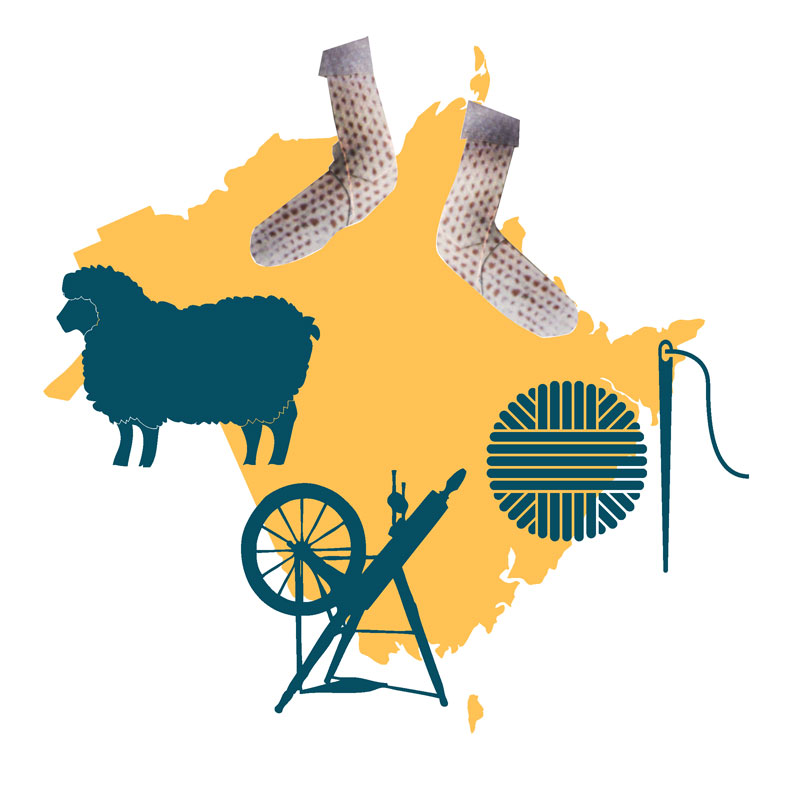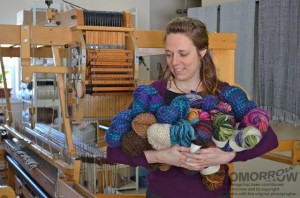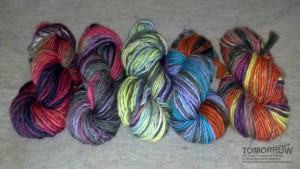Thread bare

What are we wearing, by Jason Skinner, artist in residence. Creative Commons, Attribution-NonCommercial-NoDerivs 3.0 Unported
What on EARTH are you wearing right now? And where was it made? And where are the materials from? And how much of what you paid went to the local economy?
Even if many consumers might pose the first question to their friends or family, they rarely if ever ask the latter ones.
Textiles are more than just clothing: from our wallpaper and floor coverings, bedroom and bathroom decoration, to stage and screen costumes, they include practically everything around us.
Tomorrow has investigated the state of the economy in the Canadian province of New Brunswick and what role textiles play or could play.
Could examining buying habits, agriculture and production and the assumptions made by economists lead to a textile economy? Could an area with an historic strength in crafting material and goods once again lead?
Over more than four months, Tomorrow interviewed dozens of businesses, farmers, artists, economists and others from across New Brunswick and as far as Hong Kong, Scotland and Saskatchewan.
The investigation found historic expertise and budding talent in the province, but significant and severe disconnects within government and between key players. And serious questions will need to be asked by the public about what future they want for the area and how their buying habits control whether that potential is used or abandoned.
History, economics, agriculture, land use and land rights, optimism, realism, sustainability, localism, consumerism, industry and industriousness are all bound up in the subject of textiles. And the future of a province could hinge on a mix of government action, business ingenuity and personal choice.
The long-lasting thread
Briggs & Little produce yarn.1 They’ve been doing it for more than 150 years, making them Canada’s oldest woollen mill, selling their generations of skills to generations of customers. But it’s getting harder.
“People have to realise that there’s a reason why their kids or grandkids, nieces or nephews are travelling to Alberta,” said John Little, co-owner of the family firm that employs 23 people in York County, New Brunswick. “People aren’t supporting enough local stuff. And how can [anybody] compete with the oil patch anyway? It’s almost impossible.
“If you’re a small industry and you think that you’re going to try and change people’s habits, it’s going to be a lifelong journey. I don’t think it’s going to happen overnight. People are so used to shopping for the dollars and cents price, they don’t necessarily think of the social price that they’re paying in order to save those pennies or dollars.”
 Briggs & Little keeps moving forward, trying to find new markets and appeal to new trends, but there is a long-term struggle.
Briggs & Little keeps moving forward, trying to find new markets and appeal to new trends, but there is a long-term struggle.
“They used to say the highs and lows in textiles are every seven years,” Mr Little told Tomorrow by phone. “Well, that was maybe true up until the ‘80s but since then, there haven’t been five highs since 1980. So the cycles are a lot more than seven years now.
“Our mill burned 20 years ago and when we rebuilt, it was a big decision. If we had known then what we know now, how long it would take to get back, you’d have to wonder if you would do the same thing over again.
“I’m third generation in my family, and my son works here, so we’re really trying to keep it going and wait for people to realise that they have to support more things in their back yard if they’re going to still be there next year.”
For every elder and prolific knitter that retires, the business needs to find three or four new young knitters to replace them as their need for yarn is lower for less output. And their demands are changing just as the supply moves ever further from New Brunswick.
All the wool comes direct from producers or a wool-growers co-op in Ontario and Mr Little said they have tried to vary their output over the years, including softer wools to appeal to those seeking just merino yarn, considered the best thanks to marketing, as we will report in Part 5. New Brunswick accounts for 25-30 per cent of their sales, followed by Newfoundland.
Making items at home has been a way of coping during tougher times and economic downturn, but there is so little time in most households now, particularly in two-income families and a multitude of choices for leisure activity. And Briggs & Little depends on that leisure time for their business to survive.
“That’s what it feels like,” added Mr Little. “You’re working to maintain the volumes that you have.”
The alpaca thread
To the south east in Sussex is one of New Brunswick’s newest textile firms, Legacy Lane,2 working predominantly in alpaca fleece since September 2006 and cited by nearly every single interviewee for this investigation as an example of the future potential of the sector.
Co-owner and production manager Alyson Brown and her sister Amy Tonning won a $25,000 New Brunswick Innovation Foundation prize in 20073 after completing studies in textiles and business administration respectively in the province. They had originally considered fibre farming, specifically of alpaca, because it was new and luxury and appealed to those looking for a hypoallergenic option. But they realised it was processing that was needed in the Maritimes, not more farms.
What are the bare threads of the business?
- You get 2–3lbs of fleece per alpaca animal, generally only producing once a year, from the end of May through June
- 25–30lbs needs to be processed per day for the business to run
- Just 3–5 per cent comes from New Brunswick
- Another 5–7 per cent comes from the rest of the Maritimes
- 85–90 per cent comes from the rest of Canada
There are fewer farms than when Legacy Lane opened, said Ms Brown, and large farms of 300-head would be needed to develop a full clothing line.
But transport, already a challenge in New Brunswick between a lack of public transit and ever rising fuel costs, has made business harder for Legacy Lane – a “continued thorn”, says Ms Brown. And if mills pop up between Sussex and producers in Ontario, shipping costs guide those producers to the closer mills.
Legacy Lane, employing eight or nine people depending on the season, processes fleece through to October and November for farmers who need fibre back for production in a hurry.
A farmer would tell the mill how much fleece they were sending, booking a set number of days for its processing before being sent back as finished fibre. But if not enough raw material comes in, the business struggles to meet its operating costs and they have expanded into producing wholesale lines for yarn shops and fibre enthusiasts to offset the ups and downs of farms.
“Had we only stayed just on fibre producing, I think we would probably be out of business now,” explained Ms Brown. “We have small retail space now – we’re trying to develop products and it seems to be taking off – people want to have beautiful yarns.”
Ms Brown’s education came at the New Brunswick College of Craft and Design (NBCCD),4 a centre that turned 75 last year and has become internationally reputed for their textile work.
Rachel MacGillivray is an instructor there, and someone who moved into the province even as hundreds regularly move west for high-paying energy sector jobs.
She grew up on an eastern Ontario dairy farm before going on to study fashion design at Ryerson University in Toronto. She went to work for one of the country’s largest family-owned companies as a designer in what is known as “fast fashion”, where clothing can go from concept to store rack in 15 days.
Working with large Canadian brands and their factories in China and India, Ms MacGillivray said she realised the job was not for her.
“The whole way that the fashion industry works, I had a really hard time with,” she said by phone. “The model most in use is very much [to] convince people that what they have is no good so they’ll buy more, and make as much stuff as you can, as cheap as you can so you can sell a tonne of it. There was a huge value-disconnect for me.”
It was then that Ms MacGillivray discovered the NBCCD textiles programme, moving there to learn to weave and planning to study microeconomics and developing countries in the fashion world. But the hands-on work was what she missed about fashion, leading her to stay and study fibre arts and textiles, then work as a technician and finally get taken on as an instructor.
“I’m a really avid spinner – kind of like the old fairytales,” she explained.
“I exist in the world of textiles. I’m definitely not ignorant to economics; I enjoy concepts of economics, but I’m not an economist.
“My husband and I, we’re currently looking for land to build a small farm on, to have a fibre flock. And I think that part of that business model for me is getting tours on to the farm, so people can see, okay, this is where fibre and material come from.
“When you can help people make the connection between this material which was made by these hands, it came from this field, which supports this community or it came from this animal, then people start to be more willing to pay more and then also treasure that thing, so they need less. So it’s not, ‘I’ve got to spend $200 for four sweaters every four months’.
“Connect the producers of fibre and fibre animals with the people who have the nous, the process and the equipment, the hobbyists, the knitters, weavers, and then also the people who can do it on a small-scale commercial scale to make products and sell [them].”
Ms MacGillivray said that drawing on the example of the local food movement and a backlash against fast fashion, could bring success to New Brunswick.
She argued that education, marketing and a strong local presence from farm to weaver to designer, would be key.
“Fifteen years ago there was an attitude of people, ‘I just want the cheapest stuff I can get’,” she said. “The stereotypical answer to ‘where does my food come from?’ from people in the cities was, ‘Well, from the store’.
“And then the local food movement did a really job of educating people as to why buy local, why pay more, and elevated their product into a health product that supports your community. It also has a bit of a luxury kind of feeling to it. And I think that’s what we need with textiles.
“Fashion has evolved along the same lines as fast food.
“That, I think, is a really unsustainable model, just in terms of the amount of waste created by that model. We see the horrors of that industry in the news with the factory collapses in Bangladesh because the producers are sort of forced into more narrow margins by the companies that are selling the stuff.
“And I think that that is not what we need in New Brunswick. We need a really good PR campaign to get people away from buying cheap – which is actually low quality and it’s not going to be good in six months’ time – to spending more money, investing in the community. And if you can see that this is supporting New Brunswick, there might be more of a drive to do that. Spend a bit more money but have a piece that will last longer. And you can wear it for 10-20 years.”

Illustration by Artist in Residence Jason Skinner. Creative Commons, Attribution-NonCommercial-NoDerivs 3.0 Unported
Will local sell?
Briggs & Little and Legacy Lane are emphatically local, but source raw materials for weaving from further afield and sell to further afield because there isn’t enough production or sales in New Brunswick. Could changing the local system, from farm to shop, help?
Alex McIntosh oversees business and research at the Centre for Sustainable Fashion, University of the Arts London, and is also managing director of fashion brand Christopher Raeburn.5 The centre does education, consultancy, business development and research into how fashion can exist within ecological limits and deliver better lives for those working in the sector.
Mr McIntosh, having a business himself, said that while he likes and encourages the idea of localism, it isn’t something he would force on businesses. In the case of Christopher Raeburn, the UK no longer has the skills or manufacturing base for technical, sports-wear focused items, meaning the work is best done outside the UK while they focus on heavy wool outerwear made at home.
“I also recognise that fashion is a massive global economy, for good and for bad,” he said by phone from London. “And certainly I never assume that working locally is automatically a more sustainable option. It is if you’re doing it for the right reasons and you’re doing it in the right way, and if it really is about connecting to your community and finding the skills and the materials and the resources you need. I don’t assume that that is always the right option for a business.
“You have to be clever and you have to think about the real specialism or a particular geography. What can that place deliver? What resources are available?
“If you’re going right back to the farm, and flax and linen, I’ve looked at this a lot in the UK and we have a big problem because we simply don’t have the technology or the machinery in place, or available affordable workforce to be able to engage in a human-resource heavy textile industry like linen production.
“It’s really hard to make it financially viable when you set it against the cost of producing some of the things in the East Asia. I don’t necessarily think that’s good, but it’s the reality.
By contrast, John Little said that people love the idea of buying local, but when push comes to shove, and consumers could save a dollar on something from elsewhere, “More than likely I think a lot of them would save the dollar”.
“Even if it’s developed with the idea of local, you’re still going to have to export out of here probably to make it viable,” he added. “And that isn’t really easy either. We’re so far from everywhere, from bigger markets. It’s the same for things coming in as well as going out too.”
Mini mills, said Mr Little, can produce the uniqueness of wool from one farm or area, but the cost can be 5–7 times the going price of similar commercially produced yarn. That has a market, but a lesser one. Everything was local at one time, with a mill for processing wool every 40–50 miles in New Brunswick, he said. Transportation has changed all that. It has made it easier to get products in, and so North American production, of wool and also dyes, has gone east.
“Our local stores in the little community we live in now, they’re basically just convenience stores,” he lamented. “People don’t buy their week’s worth of groceries at the local general store anymore. Everybody goes to Fredericton – it’s a 45-minute drive from here, so they are going to one of the big chains. And that’s the bulk of their supplies and then they just buy the fill-in stuff through the week at home.”
Alyson Brown said part of the problem is that local crafting has been confused with “crafts”, either the cheaper goods sold in tourism stops, or the quality goods that consumers perceive to be beyond the range of their wallets. You don’t need to be from a higher social class to celebrate industriousness and industry of craft.
“It can be an everyday thing,” she said. “Make it more accessible to people, have it more celebrated, have more fairs and more funding to things that celebrate it. Educate people on the history of it and how things were done.
“Even in New Brunswick we’ve got a pretty strong textile industry if we look at Briggs & Little. If we could somehow get people learning about the history of textiles, from where it was and where it is now, and doing that full circle. . .
“I am positive. I think there’s real promise for it and for craft in general, not just the textile industry. I use the word craft a lot because I feel like I understand its meaning. The unfortunate thing about the word craft in the rest of the world is there’s two different kinds of craft: there’s fine craft and hand-made art, and then there is kraft with a K, the tole painted birdhouses and the glued stones, the not-real-silver rings. And I don’t mean to be too harsh in that, but I think that’s kind of the importance of craftsmanship.”
Ms Brown is emphatic that there is an “absolute necessity” of pairing natural fibre with the textile industry, in New Brunswick and beyond.
“A lot was lost when the industrial revolution happened and we started working with the synthetic fibres,” she said. “Sure, a lot was gained too, but unfortunately we lost a real sense of an age-old craft and tradition that happened in homes all over the world.
“All of our clothes at one time we created by use of two sticks or a loom or a needle and thread. This is an age-old craft. To abandon that and leave the hand-made behind is just a really sad thing.
“We just don’t know where anything comes from anymore.
“Have that connection with ourselves, what we wear and what we eat, put on ourselves and put into ourselves – if you want to get corny, interweaving of people’s lives – growing something and raising something and harvesting it and transforming it.”
What is New Brunswick’s connection to textiles beyond the businesses operating today? The heritage is worth remembering.
PART 2 – The fields of blue, and ‘Scratchy as hell’
- Briggs & Little. ↩
- Legacy Lane fibre mill. ↩
- Details of Legacy Lane’s NB Innovation Foundation grant. ↩
- NBCCD. ↩
- The Centre for Sustainable Fashion and Christopher Raeburn. ↩



